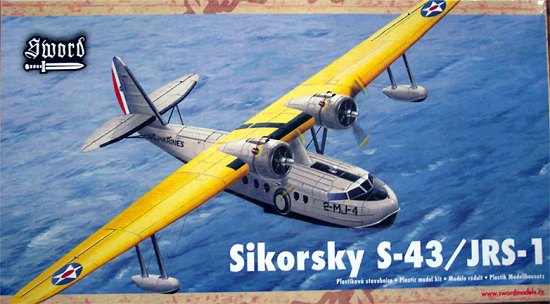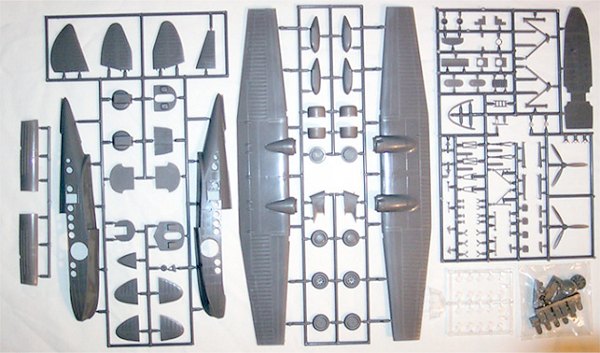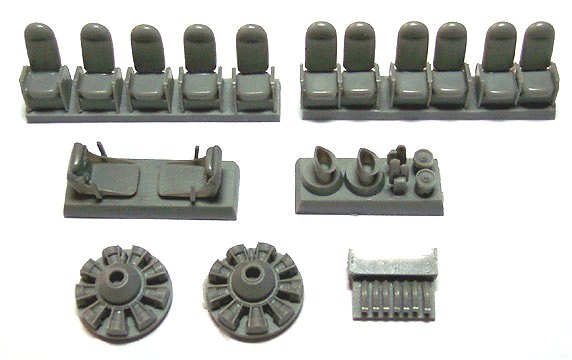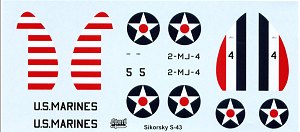
|
KIT: |
Sword 1/72 Sikorsky S-43/JRS-1 |
|
KIT # |
72019 |
|
PRICE: |
50.00 MSRP |
|
DECALS: |
Two military versions |
|
REVIEWER: |
Matt Swan |
|
NOTES: |
Pros: Excellent instructions, finely
detailed panel lines. |

|
HISTORY |
The S-43 was launched on June 5, 1935. Equipped with two 750hp engines, a top speed of 190mph, and a range of 775 miles, the S-43 reclaimed some of the commercial interest that the original S-38 had brought Sikorsky from his buyers.
The civilian S-43 amphibian was smaller version of the 4-engine S-42 flying boat used by Pan American to make survey flights across the Pacific. These were often referred to as “Baby Clippers”. Seventeen of the fifty-three S-43s manufactured were purchased by the US Navy; fourteen went to Pan Am Airlines, and four flew West African routes for the French airline Aéromaritime, as well as airlines in Russia, Norway, China, and the Philippines. Four of the S-43s were also put to use in shuttling passengers of Inter Island Airways from Honolulu to the major islands of Hawaii. Inter Island Airways became Hawaiian Airlines in October of 1941 at which time they retired the Sikorsky aircraft in favor of DC-3s.
Howard Hughes purchased one for a proposed around the world flight. Although Hughes switched to a Lodestar landplane for his journey, he kept the luxurious S-43 with its modified flush-riveted skin, 1,100hp Cyclone engines, and increased fuel capacity for personal flights. That plane crashed at Lake Meade, Nevada in 1943. It was repaired and stored at the Hughes Tool Company in Houston, Texas until 1977. It was then sold to Van Kregten Enterprise of San Jose, California for a planned museum display.
While a generally highly-regarded model, an unplanned demonstration of the S-43's power occurred on April 14, 1936 when, Boris Sergievsky, the chief test pilot for Sikorsky, made the world's first single-engine takeoff in a multi-engine plane after losing fuel pressure to the plane's right engine. That same day Boris Sergievsky piloted the S-43 to an altitude record for Class C3 amphibians of 27,950 feet.
The Navy used 15 military versions, JRS-1’s, primarily as utility transports; some were also assigned to the Army (OA-8 and OA-11) and the Marines. The thirteenth production model of the S-43 has resided at the National Air and Space Museum since 1960. This aircraft is one of ten, which survived the attack on Pearl Harbor on December 7th, 1941. Armed with bombs and depth charges fitted to the wings, it was one the first aircraft to be launched after the attack to hunt for the Japanese fleet.
|
THE KIT |

Sword is not a main-line producer and its products are the result of limited/short-run technology and I had this in mind as I opened the box. Immediately I noticed something different. The Sword kits usually come in an end-opening box where you have to slid the bag of parts out. I have the N1M Jeep kit and it’s like this. The S-43 is in a heavy cardboard box with a conventional lift off top. The differences did not stop there, on the Jeep kit the instructions were a single fold over page with a basic exploded view. The S-43 instruction book, and I mean book, is the first thing I saw. I have in my hands a twenty-page instruction book reminiscent of something from a Pro-Modeler kit. It includes a nice little history of the S-43, parts breakdown and color chart. It does not refer to any ANA or FS numbers, simply color names. The last few pages cover decal placement for two different military aircraft, landing gear details and rigging layouts for the stabilizers and outboard floats.
 Next out of the box comes
a single plastic bag containing 4 trees of parts molded in light gray
plastic. There are 115 pieces here that display finely engraved panel
lines, relatively little flash and sprue gates that are anything but
limited run quality. The sprue gates are of a size similar to any
standard run injection molded plastic model from steel molds. There are a
few injector pins on interior areas that will need to be removed but all
exterior areas are well molded. There is one injection-molded tree of
clear parts (23) that do not appear to be excessively thick, as they tend
to be in most limited run kits. The clarity of the parts is good to fair;
a treatment of Future floor coating should fix them right up. Also we
have a bag of resin pieces. There are 25 pieces caste in light gray resin
that are of outstanding quality – no air bubbles, no molding defects, no
excess flash and great level of detail, especially for 1/72 scale. The
resin pieces cover the interior seats for the crew and passengers, the
engines and exhaust manifolds. Overall there are 163 individual pieces
for this aircraft.
Next out of the box comes
a single plastic bag containing 4 trees of parts molded in light gray
plastic. There are 115 pieces here that display finely engraved panel
lines, relatively little flash and sprue gates that are anything but
limited run quality. The sprue gates are of a size similar to any
standard run injection molded plastic model from steel molds. There are a
few injector pins on interior areas that will need to be removed but all
exterior areas are well molded. There is one injection-molded tree of
clear parts (23) that do not appear to be excessively thick, as they tend
to be in most limited run kits. The clarity of the parts is good to fair;
a treatment of Future floor coating should fix them right up. Also we
have a bag of resin pieces. There are 25 pieces caste in light gray resin
that are of outstanding quality – no air bubbles, no molding defects, no
excess flash and great level of detail, especially for 1/72 scale. The
resin pieces cover the interior seats for the crew and passengers, the
engines and exhaust manifolds. Overall there are 163 individual pieces
for this aircraft.
 And finally we come to the
decals. They are not as exciting as the rest of the kit. There are no
stencils, only the basic markings for the two aircraft. Registry and
color density appear to be good and from looking at the sheet they do not
appear to be excessively thick.
And finally we come to the
decals. They are not as exciting as the rest of the kit. There are no
stencils, only the basic markings for the two aircraft. Registry and
color density appear to be good and from looking at the sheet they do not
appear to be excessively thick.
I removed the main fuselage and wing pieces from the trees and checked the fit. Panel lines matched up well and the wing tips meet evenly at both ends. There are no locator pins anywhere on the kit, which is normal for a Sword product (as well as just about any other kit from the Czech Republic. Ed). The surface of the parts is smooth and free of any Orange Peel affect.
|
CONCLUSIONS |
This is an unusual and historically significant aircraft. The quality of the kit was far above what I was expecting. I have watched the price of Sword kits climb recently and this kit demonstrates where that money is going. I had to pull an older Sword kit from the stash to compare the manufacture address to be certain that it was the same company. Not only am I looking forward to building this kit but can highly recommended it for modelers of moderate to high experience. Review kit complements of my pocket.
If you would like your product reviewed fairly and quickly by a site that has over 200,000 visitors a month, please contact me or see other details in the Note to Contributors.